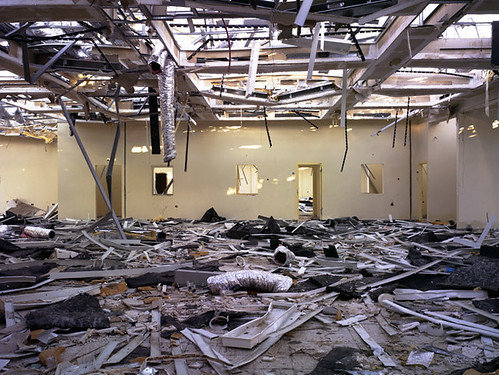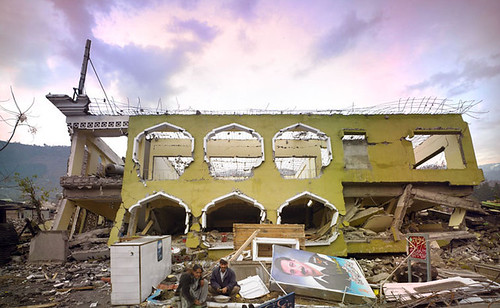the graveyard of a defiant architecture at war

[Image: Gaza International Airport, photo by Richard Mosse, Polar Inertia, 2007.]
Polar Inertia, a neverending gem of a site, features the work of photographer Richard Mosse who has covered a wide and spectacular range of urban destruction, from the ruins of an earthquake littered Iran, to the battle wounds of Lebanon’s gouged urbanity.

[Image: Gaza International Airport, photo by Richard Mosse, Polar Inertia, 2007.]
Writing for Polar Inertia about the international airport that Bill Clinton once attended for its opening, Mosse says:
"It was fully operational until December 2001, when three Israeli tanks and an armoured bulldozer damaged the runway in an effort to contain the second intifada. But the main terminal building was left untouched. For almost five years, the airport’s staff continued to turn up for work in the morning in spite of the fact that the airport was no longer operational. There were no arrivals and no departures, but the check-in desk was still manned, and the baggage belts were run each day. It must have been a kind of Marie Celeste airport. I see it as one of those peculiar situations which one comes across in these places. Reality borders the absurd, and you can’t quite work out if the whole thing is comedy or tragedy."
He goes on to tell us that during the recent war with Lebanon the Israelis also decided to completely destroy the airport, even going so far as to engrave with bulldozers the letters IDF (in Hebrew) on the tarmac – as a kind of urbicidal branding – so that it could be read from the sky. Today, the airport is a ghostly museum of war that has been turned over to local looters.

[Image: Pakistan, showing earthquake damage to Balakot city centre, NWFP Pakistan, Nov 2005, photo by Richard Mosse.]
But Mosse’s work, not entirely dissimilar from some of Simon Norfolk’s, is in an eerily magnificent way a glorious tour through the graveyard of a defiant architecture at war. Buildings so blown out by bombs that they should not even be standing at all anymore, yet somehow they do, somehow they persist.

[Image: Iran, showing earthquake damage to family home in Bam, eastern Iran, March 2004. Photo by Richard Mosse.]

[Image: Bosnia, showing shelled offices of Bosnian daily newspaper, Oslobodenje (Serbo-Croat for liberty), June 2002, photo by Richard Mosse.]
Despite their brittle bodies that have completely caved in to the goliath forces of a shaken earth, architecture’s pathetic remains manage to resist an absolute death. They are, in all their pieces, still standing, and Mosse’s work depicts a sort of monolithic pride that cannot be overcome even in the face of all out tragedy, which in some inadvertent way perhaps reveals all the more these buildings’ own devotion to the cultures who have erected them and the people who have survived them.







0 Comments:
Post a Comment
<< Home